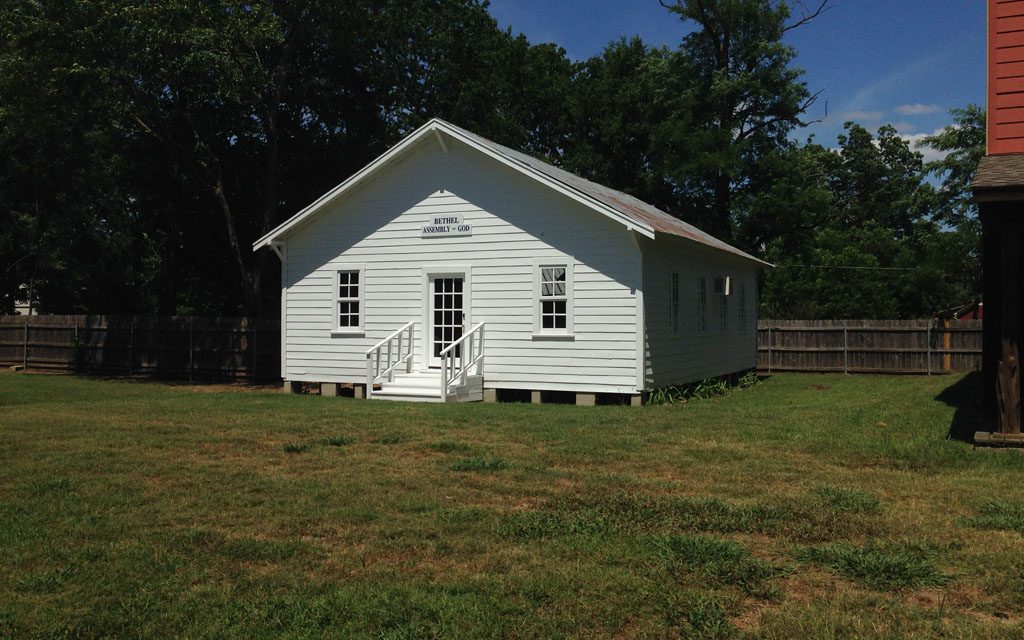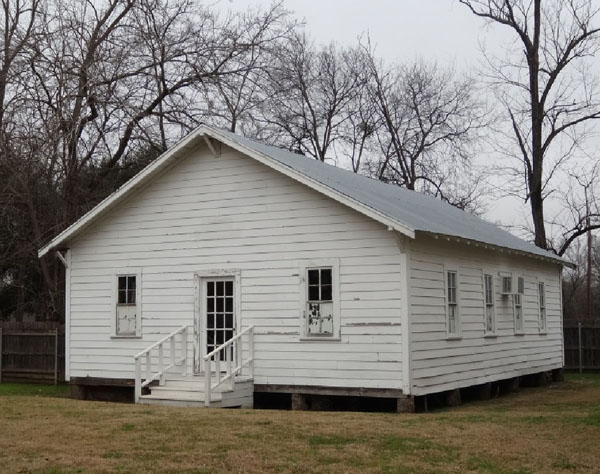by Linda Mullen
The Freestone County Historical Museum Board is very pleased to announce the completion of a “church revival” at the Bethel Assembly of God on the museum complex. Over the course of several months, several very badly needed and expensive repairs were made. The funds were hard to come by in the middle of the 1881 Jail Renovation project, but the repairs could not wait. The board is very grateful to The Summerlee Foundation for their financial assistance with this project.
The Bethel Church was started in 1933 in the Young Community by Robert Q. Hankins during the years of the Great Depression when Freestone County was known as the “Bootleg Capital of Texas”. Times were very hard and many folks had turned to the illegal production of bootleg whiskey, called “moonshine” to make ends meet. Jack Glass, a former Freestone County deputy sheriff stated, “Robert Q. Hankins did more to clean out the bootlegging in that county than they ever could by the methods of the law.”
The church was started in homes of local residents; shortly thereafter, moving into a brush arbor located between the Hickory Grove Schoolhouse and the Jameson Cemetery. In 1934, the church moved into the old school house due to cold weather and began constructing a 50’ by 30’ wooden sanctuary with a tin roof, a wood-burning heater, and white gas lanterns. An old whisky still graces its entry as a reminder of days gone by. The Church remained in operation until 1987 when the population of the rural Young community dwindled.
The building was donated to the Freestone County Historical Museum complex by the Texas Utilities Mining Company in 1992 when the land was to be mined for lignite coal. (Accession #92.547.1) The original restoration was completed in 1997 and a special dedication service was held. The church was then moved again in 2004 to the backside of the museum property, to make room for the construction of the Bass Wing.
The two front windows were deteriorated to the point beyond repair and had to be replaced. The glass was falling out and the birds were having free reign. New replacement windows were special ordered from the American Window Products in Marathon, WI at a very reasonable price. These were then installed by local home improvement craftsman, Steve Grecu.
The next phase was getting the building leveled. After obtaining several bids, the museum learned that the beams of the building frame had cracked. The church was on its way down and needed to be repaired as soon as possible. Daniel House Leveling performed this service for the museum, replacing several beams and adding extra support blocks and pads to the building.
To further preserve the historic church, a new coat of paint was needed; as the old paint was flaking off all over the building. Local painter, Gordon Small, and his crew made the old church shine like new. Volunteer, Marvin Mullen, then scraped off the peeling paint on the inside of the windows. After many years the painted windows were looking unsightly. Mr. Small informed the museum that the old time churches painted the interior of the windows to keep onlookers from looking in during church services back in the day. At some point in time, the interior window coating may be repainted.
Mulberry tree limbs had grown over the roof and were rubbing against it. The limbs had to be trimmed to protect the old tin roof. Most of the old roofing nails had also come loose over time. Danny Cockerell‘s roofing crew is to replace all of these old nails with screws to keep the tin roof from leaking and the loose sheets of tin from blowing off. The museum board has been so afraid that in recent storms the roof might blow off. Total cost of this top to bottom church renewal was just over $12,000.
Only by a great labor of love are all of the historic buildings on the museum complex maintained. It is a constant battle to keep everything in operable shape. We are very grateful to the support we receive from all of our local sponsors. Your donations are the lifeblood of the museum. Although we do obtain support from both the city and the county, these funds are mainly for general operating expenses, such as utility bills and salary benefits for our one paid employee. The city does help on a limited basis with funding for special preservation projects from the Hotel-Motel Tax fund, but only upon special request before the city council. The museum board, up to this point in time, has reserved these requests for the 1881 Jail restoration project.
The church revival project was; however, solely sponsored by funding from the Sumerlee Foundation and the museum’s own reserves. These accounts are now extremely low and have been channeled towards the completion of the 1881 Jail restoration. Any extra support from our local community will be extremely welcomed.
The Campbell Custom Homes construction team fell in love with our old jail while they were working on the Littlejohn House. The jail restoration project has now been placed in their hands and is moving along at breakneck speed!







